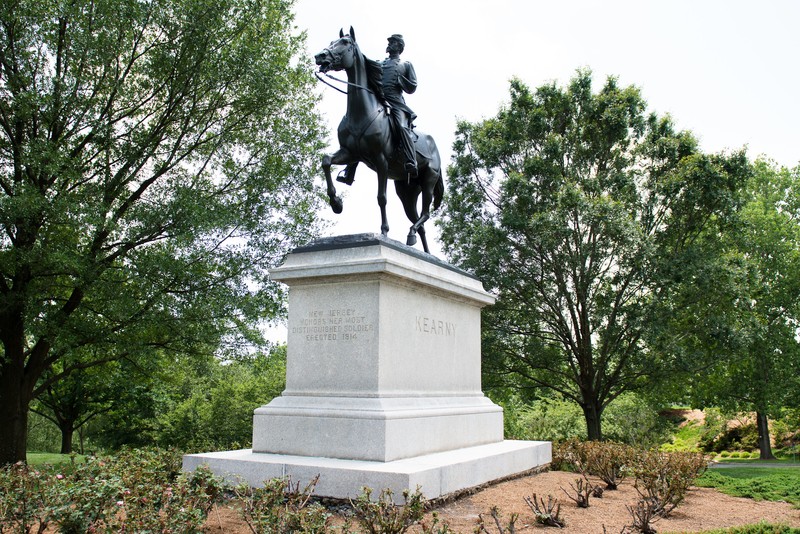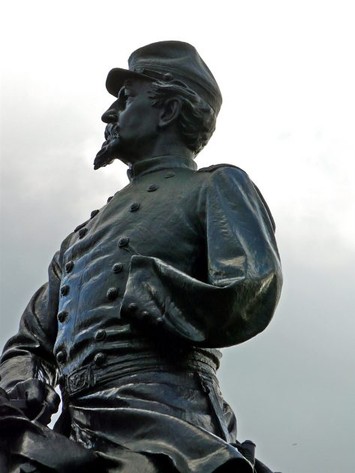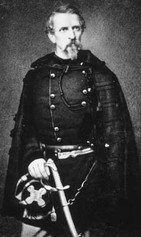Major General Philip Kearny Statue and Grave
Introduction
Text-to-speech Audio
Images
Major General Philip Kearny Statue and Grave

A closer look at Edward Clark Potter's bronze sculpture

Philip Kearny (1815-1862)

A photograph of Kearny's funeral at Arlington National Cemetery in 1912
_LCCN2016852561.jpg)
President Woodrow Wilson addresses the crowd at the statue's dedication ceremony in 1914

Backstory and Context
Text-to-speech Audio
Philip Kearny was born into an eminently wealthy and well-connected family on June 2, 1815 in New York City. His father, Philip Kearny, Sr., was an eminently successful New York financier who helped establish the New York Stock Exchange, while his maternal grandfather, John Watts, was one of the wealthiest men in the state. At a young age, Kearny lost both of his parents, and consequently was raised by Watts. He attended private schools before enrolling at Columbia College, earning his degree in 1833. Three years later, when his grandfather died, Kearny inherited a fortune worth in excess of $1 million.
Having dreamt of a military career since he was a boy, he joined the U.S. Army in 1837, and received a commission as a second lieutenant in the First Dragoons, commanded by his uncle, Stephen Watts Kearny. Two years later, Kearny traveled to France, where he attended the French Cavalry School in Saumur. In 1840, he fought with the French cavalry in Algiers. Upon returning to the United States, Kearny wrote a cavalry manual for the U.S. Army and served as aide-de-camp for General Alexander Macomb and then General Winfield Scott. During the Mexican War, he saw combat at the Battles of Contreras and Churubusco. In the course of the latter engagement, Kearny suffered a serious wound to his left arm, which eventually required amputation. Despite his disability, he continued to serve throughout the remainder of the conflict.
Following the war, Kearny resigned his commission in the U.S. Army and traveled the world, making stops in France, China, and Ceylon (now Sri Lanka). After a handful of years, he returned to the United States and settled in what was then Harrison Township, New Jersey, just outside of New York City. In the late 1850s, Kearny returned once again to France and fought alongside the French during the Franco-Austrian War, seeing combat at the Battles of Magenta and Solferino.
In 1861, Kearny returned to the United States following the outbreak of the Civil War. Soon after, he received a commission as a brigadier general of volunteers and took command of the First New Jersey Brigade. Kearny participated in the Peninsula campaign in 1862 and received a promotion to the rank of major general that July. He then took command of a division in III Corps. To more easily identify his troops on the battlefield, Kearny ordered them to place a patch of red cloth on their hats. What became known as the “Kearny Patch” eventually developed into the concept of corps badges, which the entire U.S. Army eventually adopted. While scouting enemy positions during the Battle of Chantilly, on September 1, 1862, Kearny accidently stumbled upon Confederate forces. Rather than surrender, he attempted to escape, but rebel troops shot him dead. Having great respect for the Union commander and wanting to ensure that he received a proper burial, Confederate General Robert E. Lee ordered his men to transport Kearny’s body back to federal lines under a flag of truce. His remains were interred at Trinity Church in New York City.
About half a century after Kearny’s death, the State of New Jersey petitioned to have his remains moved to Arlington National Cemetery, which they were in 1912. Around the same time, the state commissioned an equestrian statue to mark the Union commander’s new resting place. Designed by artist Edward Clark Potter and dedicated in 1914, it is only one of two equestrian statues in Arlington. The bronze sculpture depicts the one-armed general dressed in full military uniform and sitting confidently upright on his steed, which the artist portrayed in mid-stride. To better showcase the impressive monument, Kearny’s remains were exhumed for a third time and relocated to a more prominent location within the cemetery. Among those present at the statue’s dedication was President Woodrow Wilson, who delivered a speech during the ceremony.
Cite This Entry
Curran, Francis. "Major General Philip Kearny Statue and Grave." Clio: Your Guide to History. May 26, 2021. Accessed March 28, 2025. https://theclio.com/entry/135234
Sources
Jacob, Kathryn Allamong. Testament to Union: Civil War Monuments in Washington, D.C. Baltimore: The Johns Hopkins University Press, 1998.
"Philip Kearny." battlefields.org. American Battlefield Trust. Web. 25 May 2021 <https://www.battlefields.org/learn/biographies/philip-kearny>.
Warner, Ezra J. Generals in Blue: Lives of the Union Commanders. Baton Rouge: Louisiana State University Press, 1964.
Wright, John D. The Routledge Encyclopedia of Civil War Era Biographies. New York: Routledge, 2013.
https://www.arlingtoncemetery.mil/Explore/Monuments-and-Memorials/Kearny-Memorial
https://equestrianstatue.org/kearny-philip/
https://en.wikipedia.org/wiki/Philip_Kearny
https://en.wikipedia.org/wiki/Philip_Kearny
https://en.wikipedia.org/wiki/Philip_Kearny

